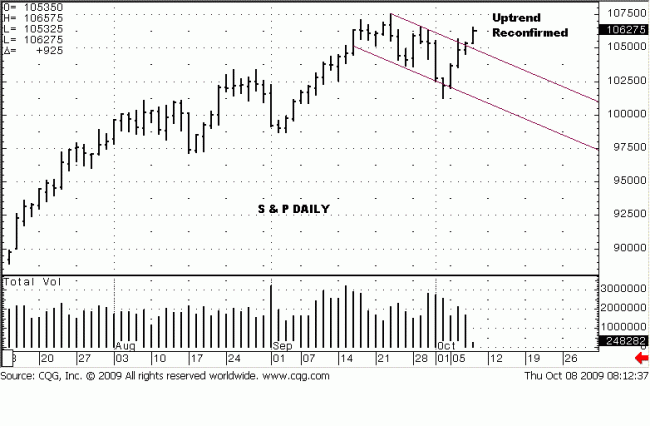Thursday 8 October 2009
The reasoned analysis of the short term S&P trade from Wednesday is an
excellent example of no matter how one views a market, always be prepared
for it to be wrong, and the best way to do that is to use stops. The intra day
trend was defined as being down, while the daily trend was on the edge of
turning sideways, but was still marginally up. Wednesday’s intra day activity
prompted a covering of half the short position that made lunch money only.
The second half position was stopped out when the previously identified
resistance point of 1056 was exceeded, prompting a $300 loss per contract.
Two points are worth mentioning to keep risk exposure manageable. The
primary one is knowledge of the trend. The intra day trend had been down
and on the cusp of turning. The daily trend was marginally up and close to
going sideways. Under this scenario, the risk exposure of going short close
to a resistance area for a short term trade was small, and it recognized that
the higher time frame daily trend was still considered up, so taking a strong
stance was not part of the plan.
The potential downside is to the 950 area, so the reasoning both of the
analysis for going short and for getting in at a potential turning point in trend
was a good risk/reward potential. One can see from the chart below,
Wednesday’s activity stayed contained within the upper level of the down
channel, but the overnight trade stopped out the position as the daily trend
was reaffirmed.
Wednesday’s very small range and inside day [high lower than Tuesday and
low higher than Tuesday] said demand was absent, [otherwise, price would
have rallied higher], but so too was supply absent by not taking advantage
of the weakened trend condition. When the higher time frame trend is up,
the benefit always goes to the direction of the higher time frame trend when
there is such a lack of demand and supply does not come in to fill the void.
Knowledge of the trend and use of stops kept the trade and outcome within reason.
Why not go long? The daily trend is not that strong, and price is near the
highest levels since March. It does not pay to “chase” a market. The structure
of market activity at these elevated levels has many problems we have
identified in previous commentaries. Plus, the high from 17 September and
the failed probe from 23 September loom just a little higher, and it does not
make sense to buy near important proven resistance.
The third point to make is trade location, implied in the above paragraph.
Wait for a pullback into known support to go long, or wait to see if the trend
weakens again, and then go short at known resistance. Anything in between
simply increases risk exposure.
Flat.




